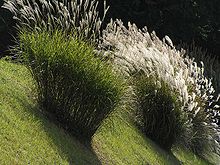- Miscanthus sinensis
-
South American Elephant Grass 
Scientific classification Kingdom: Plantae (unranked): Angiosperms (unranked): Monocots (unranked): Commelinids Order: Poales Family: Poaceae Subfamily: Panicoideae Genus: Miscanthus Species: M. sinensis Binomial name Miscanthus sinensis
Anderss.Miscanthus sinensis (Chinese silver grass, Eulalia grass, maiden grass, zebra grass, Susuki grass, porcupine grass; syn. Eulalia japonica Trin., Miscanthus sinensis f. glaber Honda, Miscanthus sinensis var. gracillimus Hitchc., Miscanthus sinensis var. variegatus Beal, Miscanthus sinensis var. zebrinus Beal, Saccharum japonicum Thunb.) is a grass native to eastern Asia throughout most of China, Japan, Taiwan, and Korea.
Contents
Growth
It is a herbaceous perennial plant growing to 0.8–2 m (rarely 4 m) tall, forming dense clumps from an underground rhizome. The leaves are 18–75 cm tall and 0.3–2 cm broad. The flowers are purplish, held above the foliage.
Cultivation
It is widely cultivated as an ornamental plant in temperate regions around the world.
It has become an invasive species in parts of North America.[1] However, it is possible to reduce the likelihood of escape or hybridization with extant wild M. sinensis populations with breeding and proper management. [2]
Cultivars
Several cultivars have been selected, including Stricta with narrow growth habit, Variegata with white margins, and Zebrina with horizontal yellow and green stripes across the leaves.
- Miscanthus sinensis 'Border Bandit'
- M. sinensis 'Dronning Ingrid'
- M. sinensis 'Gracillimus'
- M. sinensis 'Malepartus'
- M. sinensis 'Morning Light'
- M. sinensis 'Variegatus'
- M. sinensis 'Zebrinus'
Uses
M. sinensis is a candidate for bioenergy production in the United States due to its high yield, even in high stress environments, easy propagation, effective nutrient cycling, and high genetic variation.[3]
Gallery
Notes
- ^ Chinese silvergrass. Invasive.org: Center for Invasive Species and Ecosystem Health, February 2, 2010. Accessed May 28, 2010.
- ^ Quinn LD, Allen DJ, Stewart JR (2010) Invasiveness potential of Miscanthus sinensis: implications for bioenergy production in the United States. Global Change Biology Bioenergy. 1-2, 126-153.
- ^ Stewart R, Toma Y, Fernández FG, Nishiwaki A, Yamada T, Bollero G (2009) The ecology and agronomy of “Miscanthus sinensis”, a species important to bioenergy crop development, in its native range in Japan: a review. Global Change Biology Bioenergy. 1-2, 126-153.
References
External links
Categories:- Poaceae
- Flora of China
- Flora of Japan
- Flora of Korea
- Garden plants
- Grasses
Wikimedia Foundation. 2010.





